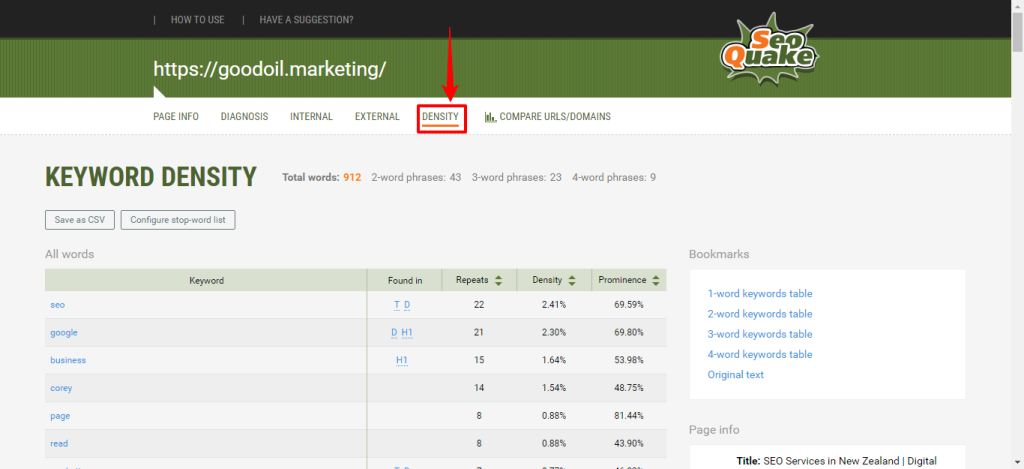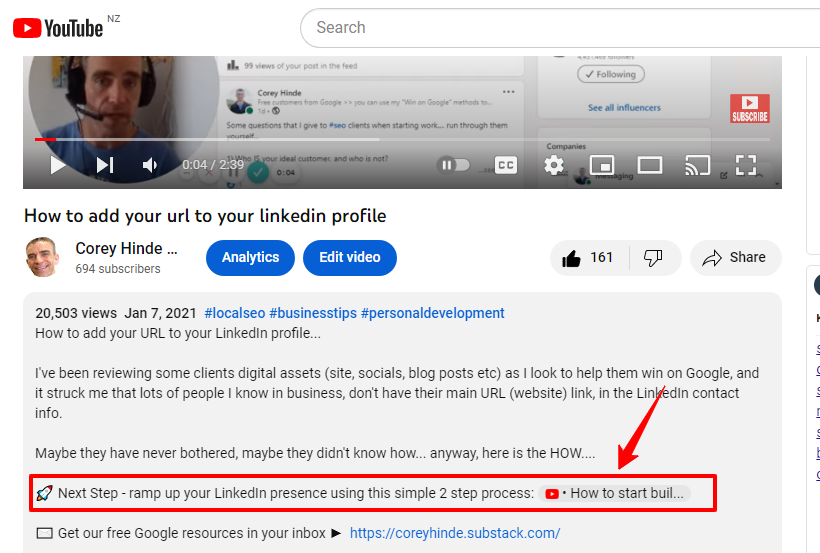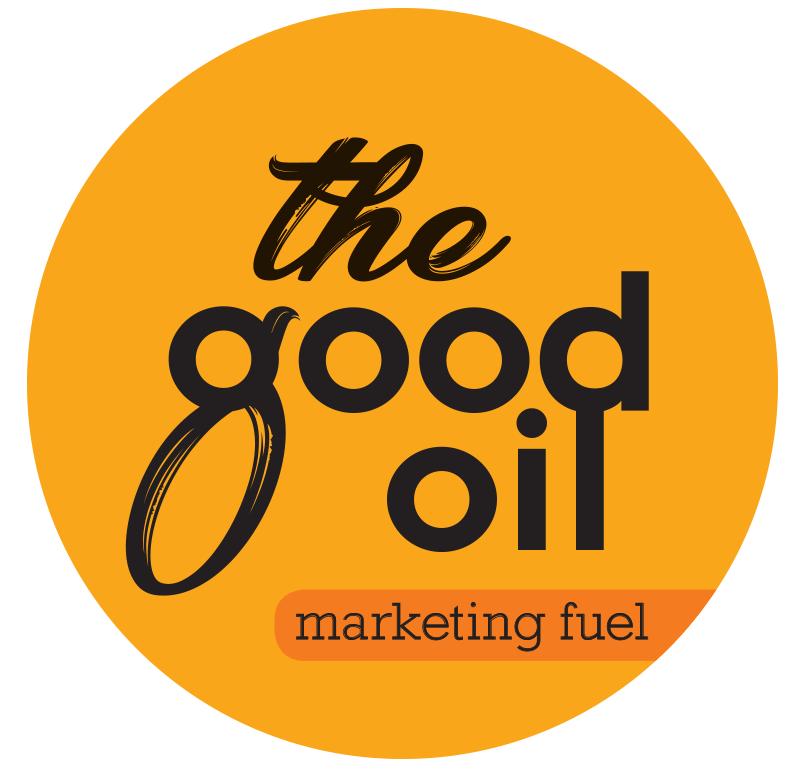Got a business with a website?
Want to rank higher on Google so you can get more leads and sales?
This is the challenge for you!
Our goal here is to give you an easy to follow process that will help your website perform better on search engines (Google).
If you need help, we have 3 options:
1️⃣ Our Facebook Group, Digital Marketing for Rookies, has some free help and advice. Likewise, our Substack Library has some great tutorials. We also have loads of YouTube Videos that are free, and helpful.
2️⃣ Our Marketing Community has a very small monthly fee, and is an amazing place to get help DOING this stuff.
3️⃣ If you are keen to hand this stuff over to the experts, you can HIRE US to do it for you.
📌
Let’s start the Challenge – follow these steps:
🚀 Step 1 – go to the following Facebook post and list your Business website in the comments:
https://www.facebook.com/groups/digitalmarketingforrookies/posts/1572919309859843
🚀 Step 2 – What do you want to rank on Google for?
What is your goal re words and phrases to rank on Google?
What do your best prospective customers search for on Google, when looking for your type of business?
There are usually 1-2 KEY phrases that will move the needle for your business, and then another layer of words that are supporting that main 1 or 2.
This is KEY.
Often, people want to grow their business, build a website, and haven’t thought at all about what main words or search phrases their ideal clients are using on Google.
SO – I want YOU to list your main phrase or phrases that you want to win on Google for, as a reply to your comment above.
TO help you with this, I have a few resources:
1) This YouTube video: https://youtu.be/DAIdMw9125E
2) If you sign up to the SEO tool I use, Mangools, you can get a FREE 10 day trial – which I highly recommend – this link here is KW Finder which will help you research your keywords https://mangools.com/kwfinder#a5ddf2340feebf83a3fda06aa
SUMMARY – what do you want to rank on Google FOR, and please jot that in the comments in the Facebook Group OR below on this blog post as a reply to your initial comment.
Ps – you’ll find this video useful as well for how to use KW Finder: https://youtu.be/MKwt-APBc94
🚀 Step 3 – Set up Keyword Tracking
Tracking your keywords will help you know if you are on the right track.
Tracking them, and then also watching your Google Search Console data, will help you know if you are doing well.
We recommend firstly ensuring you have access to your Google Search Console data (article on our blog HERE about that).
Then we suggest you set up keyword tracking.
There are MANY ways to monitor Keywords for rankings, however getting this FREE is no longer easy.
We suggest you either sign up for our preferred tool Mangools HERE and get their free 10 day trial (if you do join a paid plan at some point, we’ll get a small commission at no extra cost to you) or find another option online – these do change from time to time.
The most frequently used SEO tools, called AHrefs and SEMrush are both amazing tools, but for most small businesses, they are quite an expense so we’ll try and put cost effective options in front of you.
The Mangools tool you will use for keyword tracking is called Serpwatcher – it’s really clever and tracks your current rankings, the search volume of the words you are tracking, and your improvements etc.
Alternative option – Neil Patel’s Ubersuggest has been highly recommended as well. We suggest you select something that you enjoy, and feel you can easily use. This can help you with keyword research as well as tracking.
Sometimes, simply knowing what main keyword you want to win on Google, will help push you much higher on Google! You’ll naturally start creating more related content, including that word or phrase and related words / phrases in your content… get tracking those keywords!
🛑 AD:
Click HERE if you would like to purchase a copy
👀 Don’t forget to get our regular free email updates HERE 👀
This next video is a pre-requisite to step 4 which is below:
🚀 Step 4 – Meta Title on your Website
The meta title is one of THE most important “hints” you can give Google.
In this step, you’ll reflect on your Keyword Research above, and also the video above this step, and decide upon one phrase to use as your Meta Title for your website.
As noted in the video above, a Meta Title will appear in Google search as shown in the image below:

All website builders will have provisions for you to edit the Meta Title.
The phrase you use is important – so make sure it aligns with your business, and what ideal clients / customers are searching for.
You may have heard us refer to this before as a “Bullseye Phrase”
More information in the video below – it’s an older video now but the principles apply – this is a VERY important step so please watch the video and the video above step 4 as well:
🚀 Step 5 – Align your content with your main Keywords.
What does this mean?
Look through your website, and ensure that your pages and blog posts etc are on topic. Is everything on your website related to the main words and phrases you are trying to win on Google?
This is a subjective step – just cast your eyes over your website and think – is this telling Google what we do and the solutions or products we have?
Here are 3 mini-steps for this section:
1️⃣ List out ALL the questions you get in your business. Go through emails, sms questions, Facebook comments, ask staff. What are the most common questions you get – and then start doumenting answers to those questions. This will be useful later on, and also for generally creating marketing content that gives Google more hints.
2️⃣ Watch this YouTube video for more help with the above:
3️⃣ Install “SEO Quake” on your desktop, and get a keyword density check done.
Google “Install SEO Quake”.
Add the chrome extension to your desktop.
Open your website, then click on the SEO Quake icon.
Click on Density, you’ll see something like this:

Do the words that are most dense make sense to you and what you are trying to win on Google for?
If they do not, then you need to think about how you can write more articles and pages that do use those words.
The previous step of writing out Questions and Answers about your business is the starting point for that.
🚀 Step 6 – Meta title (BullsEye Phrase) related questions, online, getting Googles attention.
Sounds kinda weird.. let me explain.
In the steps above, you’ll have identified some keywords you want to rank on Google for.
Hopefully, you’ve also identified a “BullsEye Phrase” – ONE key word or phrase that stands out.
We generally get people to use that BullsEye Phrase in their Meta Title in the above step.
THIS step is all about creating Questions AND Answers – around 10 of them – that are related to your BullsEye Phrase, and therefore related to your business.
You are going to list out the questions, then get them out onto whichever social media platforms you use, to send HINTS to Google about what you do.
We suggest you use Publer – a social media tool – to do this.
So – here are the mini-steps in this stage:
1️⃣ Based on the YouTube video above (How to create marketing content), and the Keyword work above, write out a list of at least 10 questions you find that are related to your business. Then write out answers to them as well. They must be ‘related’ to your key phrases and bullseye phrase.
2️⃣ Visit our article on how to use Publer (CLICK HERE) – and create an account on Publer. We suggest you connect to at least 3 social accounts you use, for example Facebook + LinkedIn + Google Business Profile.
3️⃣ Over the course of several days, disperse the Questions and Answers across your social media platforms using Publer. You can go as far as you like with this step, in fact, the more Q and A’s you can get out there onto social platforms, the better.
Then, keep an eye on the data from the social platforms to see which questions get the highest reach, most engagement etc. This will be useful later on.
🚀 Step 7 – Technical and Speed Audits
This is important – but for the most part beyond the scope of this challenge.
However – we’ll still run some audits because glaring technical issues or a really slow website WILL cost you rankings and user experience on Google.
The goal here is to quickly identify any issues, and then either ask / pay your developer to solve it, or find another solution that suits you.
1️⃣ Run your website through the Pagespeed Insights Tool from Google. 👈 click here
Google will give you a report from that tool, pay attention to what it highlights.
Then, run your site through the go-to speed checker tool, GT Metrix. 👈 click here
2️⃣ Next, run your site through this cool free audit tool, SEOptimer. 👈 click here
You’ll get a good overview of the health of your website, and any issues that need fixing will be highlighted for you there.
The idea here is to find any major issues affecting speed or technical aspects of your site, then find WHO can fix it rather than trying to do it yourself.
🚀 Step 8 – Citations | Business Directories
This step is easy, but might take a while.
Visit THIS PAGE on blog – and ensure that:
1️⃣ You are listed on as many Business Directories as possible (this is a New Zealand specific list, Google will help you find your best list if you are not in New Zealand)
and
2️⃣ Ensure that your details are consistent across all of the listings. In particular, your Website URL, your business name, your address, and your phone number.
🚀 Step 9 – Bullseye Phrase Usage
This step follows on from the other keyword and bullseye phrase steps.
We want to ensure that Google REALLY understands what you are all about.
You are going to check that your Bullseye Phrase (BEP) or main keyword, is present in the following places:
1️⃣ The Meta Title of every page on your site
2️⃣ The H1 or main heading of every page
3️⃣ The first paragraph of every page
4️⃣ The content of every page.
Now – don’t panic if your BEP isn’t in all of those spots, on every page.
Ask yourself though:
“If my BEP isn’t present on those spots on each page, is something ‘related’ to my BEP in those spots?”
Google is very good at linking related terms together, and building a picture of what your website is about. Sometimes, you might though have to ask yourself if certain pages and content needs to be edited or removed.
🚀 Step 10 – Get a backlink
A backlink is where a website, links TO your website.
Google loves backlinks – they are a key way that Google decides who ranks where on Google to put it plainly.
It’s a strong sign of authority – to both Google and to people as well.
There are MANY ways to get backlinks – we’ve already discussed one form of backlinks above in step 8 – the directories and citations steps.
To get backlinks, website owners generally decide that you are an expert in an area, or have something very useful, so link to you OR they respond to a request from you to link to your site.
The goal in this step is to get 1 backlink – go for more if you like, but we know that once people get 1 good backlink, life starts to get easier in the game of ranking higher on Google.
We have discussed how to get backlinks in various places before, so here are 2 good resources to educate you more about Backlinks, and how to go about getting them:
1️⃣ This article HERE on our Substack – called “How to get Friendly Backlinks – for Rookies”
and
2️⃣ This article on our blog HERE – aptly named “How to get Backlinks”
You are more than welcome to pop into our Facebook Group – Digital Marketing for Rookies – and ask questions about backlinks as well. We’d love to see you succeed in this step!
🛑 Join our Coaching Community HERE – pick our brain anytime 🛑
🚀 Step 11 – LinkedIn alignment
Our goal here is to ensure you are tapping into the power of LinkedIn to help your SEO efforts.
Google loves LinkedIn – it’s a high authority site and Google trusts its content.
In this step, we want to ensure that you and staff are connecting LinkedIn profiles to your website, you are also using the LinkedIn company page option, and then starting to get active on LinkedIn as well.
1️⃣ Make sure that you have a LinkedIn profile, and that your “contact info” has a link to your website. See if you can get key staff to do the same.
Here is HOW you set up a link from your LinkedIn profile:
2️⃣ In the description for that video, you’ll see a link to another YouTube video. Watch that video as well. This details a very easy 2 step process for getting more out of LinkedIn.

3️⃣ Set up a LinkedIn “Company Page” as well.
We won’t detail how to do this, there are various guides online for this that are fine.
Goal here is – set up a company page on LinkedIn, and if you have time, get 1-2 posts on there as well that are directly related to your keywords and bullseye phrases described earlier.
🚀 Step 12 – Create an “Ultimate Guide” and more supporting content
This step follows on from step 5 above and uses content to get more website traffic.
The idea is to build one “ultimate guide” that is suitable for your business, and once that is done, create more articles and content related to that ultimate guide as well.
Here is a helpful video that explains more about Ultimate Guides:
Building more and more content, in a structured way, is the key to your ongoing work to keep growing your websites rankings, traffic, and ultimately revenue.
SEO consultants work primarily fixing technical issues + creating content + building links to your site.
🚀 Next Steps:
1️⃣ Ensure you are on our Substack List – sign up HERE. Being on this list will keep you going with your own efforts if that is what you want to do.
2️⃣ Consider joining our Marketing Community – sign up HERE. This way, you can pick our brains anytime and ensure you fast track your success!
🛑
